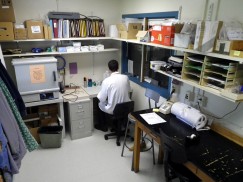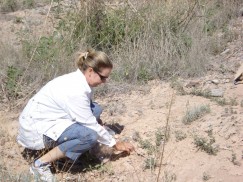- Home
- >
- Preservation Archaeology Blog
- >
- What does a nuclear reactor have to do with prehis...
 |
By Deborah L. Huntley, Preservation Archaeologist
|
Every once in a while, my research requires me to do something a little out of the ordinary. For example, this spring I spent several days at the University of Missouri Research Reactor (MURR) in Columbia. I was there to analyze ceramic compositional data collected at the MURR Archaeometry Laboratory for nearly 500 sherds from Upper Gila archaeological sites. One of the many things the Archaeometry Lab specializes in is Neutron Activation Analysis (NAA) of pottery and other materials. Let me explain a little bit about how this works for all of the non-nuclear physicists out there…

The main goal of NAA for Archaeology Southwest’s research in the Upper Gila is to identify chemically similar groups of samples that can be linked to particular geographic sources. NAA operates on the principle of radioisotope decay. Researchers send pottery and clay samples to MURR, and the technicians remove a small amount of pulverized ceramic paste from each sherd, clean away any slip or paint from the sample, and sent it via pneumatic tube to be irradiated. Following irradiation, radioactive isotopes of various elements within the samples decay, giving off gamma rays with energies that are characteristic of different isotopes. The concentrations of elements within a particular ceramic sample are then determined by measuring the gamma ray emissions at two separate points in time (the “short” and “long” counts). Sample elemental concentrations are compared with standard reference materials. MURR typically determines concentrations for 33 major, minor, and trace elements.
Sample preparation and analysis at MURR usually takes 3–4 months. After that, the real fun begins. All of the raw data needs to be analyzed using various statistical methods and interpreted. This is why I travelled to MURR: to work with Jeff Ferguson at the Archaeometry Lab to learn firsthand how to use the Lab’s statistical programs and get some guidance in how to identify meaningful patterns in the Upper Gila NAA data. I arrived in Columbia on a balmy day in May, checked in at the security desk (security is a big concern for a reactor facility, as you can imagine), put on my portable Geiger counter, and got to work.

The first thing we did was plot various combinations of samples (by site or by region or by ceramic type) using different combinations of elements. Doing that allowed us to see chemically similar groupings of samples. Some patterns then began to develop. For example, particular groups of samples seemed to correspond to particular sites or sets of sites along the same river drainage. This is a nearly ideal situation, because one of the major assumptions of provenance, or sourcing studies, is that pottery production loci can be identified through the criterion of abundance–in other words, the most common chemical signature present in pottery from a given site is assumed to be “local.” Comparison of ceramic paste compositions with locally available raw clays (see Image 2) allows us to make a stronger argument for the identification of local versus non-local pottery. Once the chemical signatures of pottery from different production loci have been identified, we can trace exchanges between production loci.
It wasn’t all nose-to-the-grindstone on my MURR visit. I did get a tour of the facility, and yes, I got to see the nuclear reactor, glowing blue core and all. That was definitely a highlight for me.
Data analysis is still in progress, and I expect to have an update on our findings in a few months. Stay tuned!
The Archaeometry Lab at MURR is directed by Dr. Michael Glascock, and Dr. Jeffrey Ferguson supervises much of the sample preparation and data analysis. More information can be found at the Lab’s website.
Explore the News
-
Join Today
Keep up with the latest discoveries in southwestern archaeology. Join today, and receive Archaeology Southwest Magazine, among other member benefits.